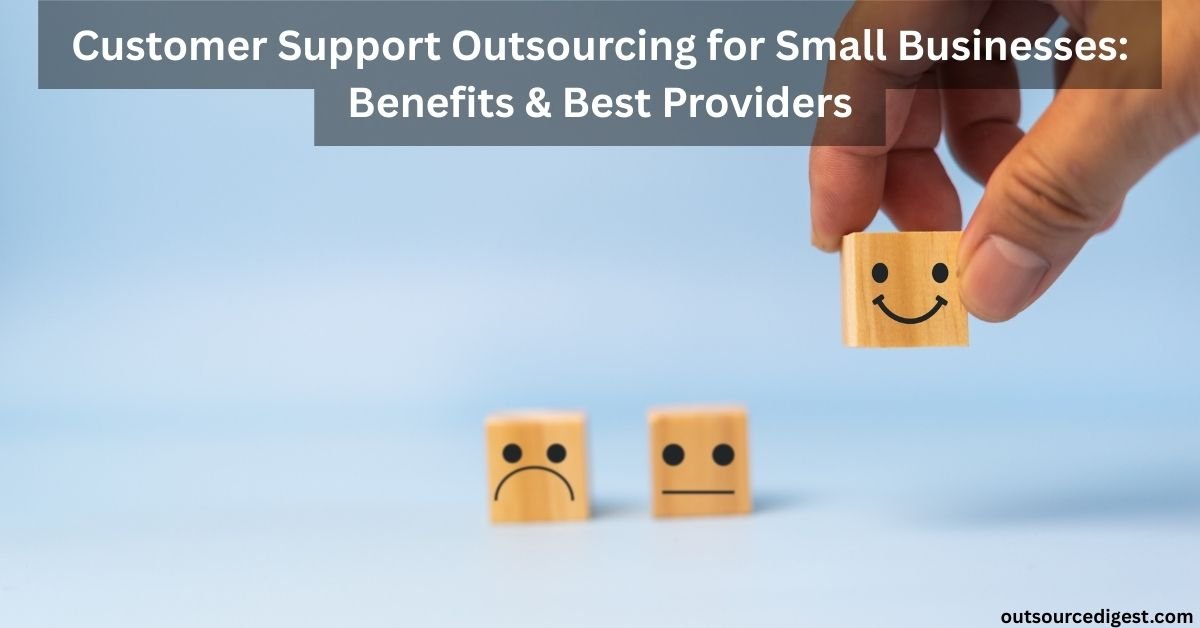Small businesses are competing in an era where customer experience often defines success. Yet many small and medium-sized businesses (SMBs) lack the budget, staff, or technology to maintain a full-time, high-quality customer support team. That’s why customer service outsourcing for small business has become a popular, strategic choice in 2025. By partnering with specialized customer support outsourcing services, SMBs can deliver faster responses, professional interactions, and 24/7 availability — all without the overhead of running an in-house support operation.
Many U.S. companies are outsourcing their call centers to cut costs and scale faster. You can explore this broader trend in our guide: Why More US Companies Are Outsourcing Call Centers in 2025.
This article explains the benefits of outsourcing customer support for small business, how to choose the right provider, the service models available, and the best providers to consider in 2025. Wherever relevant, you’ll find practical tips to ensure the partnership supports your brand and customer expectations.
Why Small Businesses Outsource Customer Support in 2025
- Cost Efficiency and Predictable Expenses
Running an internal support team means recurring costs: salaries, benefits, office space, recruitment, training, and software licensing. For many SMBs, these fixed costs are unsustainable. Customer service outsourcing for small businesses turns unpredictable overhead into predictable monthly expenses. Outsourcing providers spread their costs across many clients, allowing SMBs to access professional support at a lower per-client price.
- Access to Professional Talent and Training
Top customer support outsourcing services offer agents trained in best practices, escalation handling, and soft skills like empathy and de-escalation. Instead of investing months to recruit and train, small businesses tap into experienced teams who already know how to handle common issues and represent brands professionally.
- Faster Time-to-Market for Support Operations
If your business is scaling rapidly or launching a new product, setting up a support team from scratch can cause delays. Outsourcing enables immediate onboarding and ramp-up, critical when support demand spikes during promotions, launches, or holiday seasons.
- 24/7 Availability and Global Coverage
Customers expect help at any hour. Outsourced providers offer distributed teams across time zones or follow-the-sun models so your business can deliver support around the clock without hiring night-shift staff locally.
- Technology and Omnichannel Capability
Modern customer support outsourcing services provide integrated technology—CRMs, chat platforms, knowledge bases, and analytics. SMBs benefit from omnichannel coverage (phone, email, chat, social) and data-driven insights without the cost of licensing and integrating these systems themselves.
- Reduced Management Burden
Managing hiring, retention, and day-to-day staffing distracts founders and small leadership teams from core business activities. Outsourcing shifts workforce management to the provider, allowing you to concentrate on product, marketing, and growth.
Common Concerns and How Providers Mitigate Them
- Brand Control and Voice
SMBs worry that outsourced agents won’t sound like their brand. Reputable providers mitigate this with dedicated onboarding, brand voice guidelines, scripted and unscripted training, and regular QA sessions. Choose a provider that offers custom training and brand immersion sessions.
- Data Security and Compliance
Handling customer data requires robust security. Look for providers with certifications and compliance measures relevant to your industry (e.g., PCI DSS for payments, HIPAA for health-related data). Contractual Data Processing Agreements (DPAs) and secure access controls are essential.
- Quality and Oversight
Quality concerns are real, but modern providers offer transparent reporting dashboards, service-level agreements (SLAs), and frequent performance reviews. Demand clear KPIs—first response time, average handle time, CSAT/NPS scores—and insist on shared dashboards.
- Cost vs. Value Tradeoff
Some SMBs fear that outsourcing sacrifices quality to save money. The right partner balances competitive pricing with service quality. Focus on outcomes (customer satisfaction, resolution time, sales conversions) rather than purely hourly or per-ticket costs.
Customer Support Outsourcing Models for Small Businesses
Dedicated Team Model
A provider assigns a team of agents dedicated to your account. This model is ideal for businesses needing deep product knowledge, consistent brand voice, and predictable volume. Dedicated teams act like an extension of your company.
Shared/Blended Team Model
Agents handle multiple client accounts but use client-specific scripts and knowledge bases. This is a cost-effective option for SMBs with stable but moderate support volume.
Project-Based Support
Use this for limited-time needs: seasonal spikes, product launches, or migrations. Providers assemble a short-term team focused on specific tasks and goals.
Hybrid Model (In-house + Outsourced)
Some SMBs keep internal teams for high-touch or strategic customers and outsource standard inquiries. The hybrid model offers control where it matters and efficiency for routine tasks.
Fully Managed Outsourcing
The provider handles end-to-end support operations: hiring, training, technology stack, and day-to-day management. This is suitable when the SMB lacks internal resources to manage support.
How to Choose the Right Customer Support Outsourcing Services
- Define Your Goals and KPIs
Before evaluating providers, decide what success looks like: reduced response time, higher CSAT, increased retention, or improved conversion rates. Clear KPIs make the provider selection objective.
- Prioritize Industry Experience
Providers with experience in your industry understand common issues, compliance needs, and customer expectations. For niche sectors (e.g., fintech, healthcare), prioritize domain expertise.
- Evaluate Cultural and Language Fit
If your audience is primarily US-based, ensure agents have strong English skills and cultural understanding. Accent clarity, idiomatic knowledge, and context-aware responses improve customer satisfaction.
- Check Technology and Integrations
Your support must integrate with your CRM, helpdesk, and order systems. Confirm the provider supports required integrations (Zendesk, Freshdesk, Salesforce, Shopify, etc.) and can maintain data consistency.
- Review Security Practices and Certifications
Ask about data encryption, access controls, background checks, and relevant certifications. For payment or health data, insist on demonstrable compliance.
- Ask About Training and Onboarding Processes
Robust onboarding ensures agents understand your products and policies. Request sample training materials, shadowing plans, and a timeline for ramp-up.
- Examine Pricing Models and Contract Flexibility
Look beyond sticker price. Ask about minimum terms, exit clauses, seat-based vs. per-contact pricing, and scalability. Flexible contracts reduce long-term risk for SMBs.
- Request Case Studies and References
Ask for references from similar-sized clients or industry peers. Real-world case studies reveal how the provider handles issues like spikes, escalations, and migrations.
Top Customer Support Outsourcing Services for Small Businesses in 2025
Below are providers that frequently appear as strong choices for SMBs in 2025. Each has strengths that appeal to small businesses seeking reliable, scalable support.
Provider A — Small-Business-Focused Outsourcer (Example: ReplyCo / Boutique Providers)
These boutique firms specialize in supporting SMBs with tailored onboarding, close account management, and competitive pricing. They often provide flexible plans and quick responses during ramp-up periods.
Why SMBs choose them: Dedicated onboarding, US-based account managers, fast setup, and strong cultural fit for American customers.
Provider B — Technology-Driven Outsourcer (Example: Outsourced Support with AI)
These providers combine human agents with AI tools for routing, knowledge retrieval, and ticket summarization. The result: faster resolutions and lower handle times.
Why SMBs choose them: Integrated bot + agent workflows, analytics dashboards, and affordable per-contact pricing.
Provider C — E-commerce Specialist (Example: E-commerce CX Providers)
Providers focused on retail and e-commerce understand order systems, returns, and platform integrations (Shopify, Magento). They can handle peak seasons like Black Friday efficiently.
Why SMBs choose them: Deep platform integrations, seasonal staffing expertise, and sales support capabilities.
Provider D — Offshore/Nearshore Cost-Effective Providers
For SMBs on tight budgets, reputable nearshore or offshore providers offer lower hourly costs while maintaining strong English-language coverage and cultural alignment.
Why SMBs choose them: Cost savings, time-zone overlap (nearshore), and rapid scalability.
Provider E — White-Label & Dedicated Teams
If brand control is paramount, white-label providers act as your support team with complete brand immersion. They can manage voice, email, and chat as if they were internal staff.
Why SMBs choose them: Seamless brand consistency and full control over scripting and escalation.
Note: Replace the placeholder provider labels above with vendors you prefer or have vetted for your niche. Always validate current capabilities and references before signing a contract.
Practical Onboarding Checklist for SMBs Outsourcing Support
- Document Your Brand Voice — Provide tone guides, what to and what not to do, and sample responses.
- Share Knowledge Base — Current FAQs, product manuals, and troubleshooting steps.
- Set Clear SLAs — Response times, first-contact resolution targets, escalation paths.
- Define Reporting Cadence — Weekly metrics review, monthly performance deep dives.
- Integrate Systems — Ensure CRM/helpdesk/API access for ticket sync and order lookup.
- Plan for Security — Set up secure credentials, user roles, and auditing.
- Design Escalation Rules — Who to contact for refunds, legal issues, or technical bugs.
- Run a Pilot — Start with a limited volume to test workflows, tone, and reporting.
Measuring Success: KPIs That Matter
- Customer Satisfaction (CSAT) — Direct measure of how customers perceive interactions.
- First Response Time (FRT) — Speed matters for perception.
- First Contact Resolution (FCR) — Resolving issues in one interaction reduces cost and friction.
- Average Handle Time (AHT) — An Efficiency metric, but should not sacrifice quality.
- Net Promoter Score (NPS) — Tracks loyalty and likelihood to recommend.
- Cost per Contact — Ensure outsourcing reduces cost while maintaining or improving quality.
Red Flags When Evaluating Providers
- Lack of transparent metrics or unwillingness to share performance dashboards.
- No clear process for security and data protection.
- High agent turnover without a plan for continuity.
- One-size-fits-all scripts with no brand customization.
- Long minimum contract terms with steep exit penalties.
Final Recommendations
For many small businesses, customer service outsourcing for small business is not just an expense-saver — it’s a growth enabler. The right customer support outsourcing services let you scale support, maintain high-quality interactions, and free internal teams to focus on product and revenue.
Start small with a pilot, measure rigorously, and prioritize providers that demonstrate cultural fit, strong onboarding, and transparent reporting. If brand voice and customer experience are critical to your business, invest in a dedicated or white-label model. If cost is the primary constraint, consider nearshore providers with proven English fluency.



